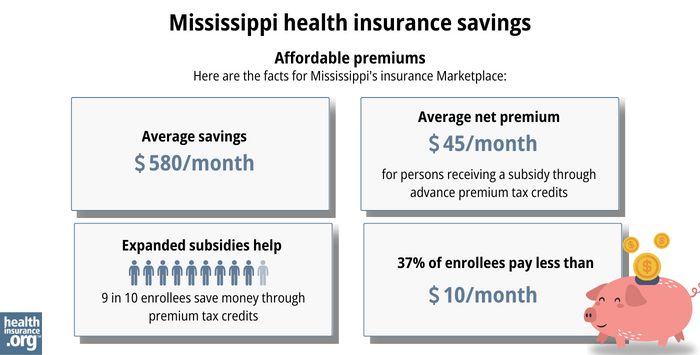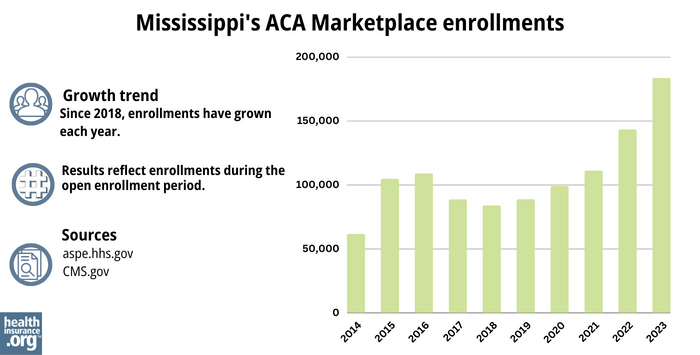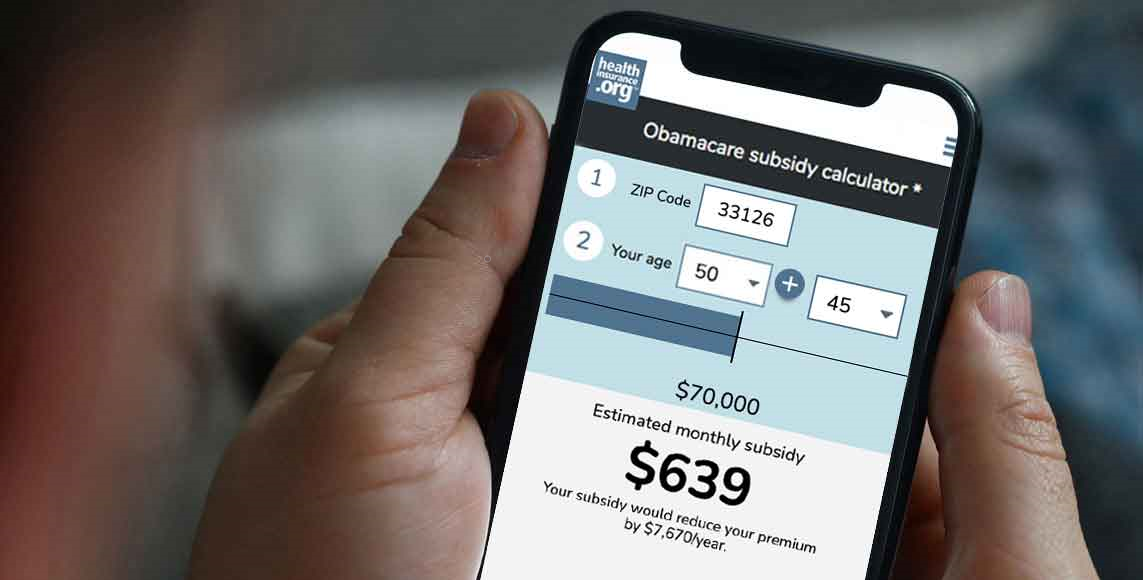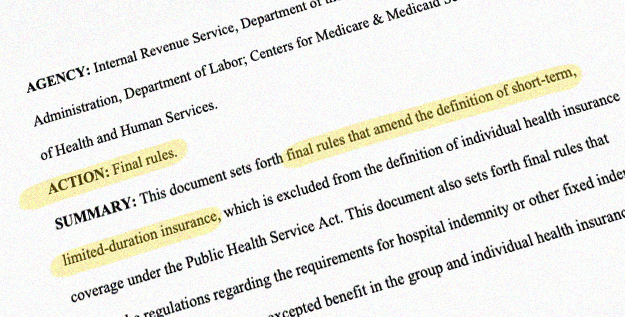Home > States > Health insurance in Mississippi
See your Mississippi health insurance coverage options.

Find individual and family plans, small-group, short-term or Medicare plans through licensed agency partners.

Mississippi Health Insurance Consumer Guide
Use this guide to help you find the right health plan in Mississippi. Many people find an ACA Marketplace (exchange) plan, also known as Obamacare, to be a cost-effective choice.
Mississippi uses the federally run health insurance Marketplace, Healthcare.gov, for residents to purchase ACA-compliant plans. The Marketplace provides access to health insurance products from five private insurers. Coverage areas vary, but residents in all Mississippi counties have access to Marketplace plans from at least three insurers as of 2024.1
Depending on your income and other circumstances, you may also get help to lower your monthly insurance premium (the amount you pay to enroll in the coverage) and possibly your out-of-pocket expenses.
Explore our other comprehensive guides to coverage in Mississippi
Dental coverage in Mississippi

Need dental coverage? Learn about available options and find the right dental plan in Mississippi with our guide.

Mississippi’s Medicaid program

Mississippi has not expanded Medicaid eligibility as allowed under the Affordable Care Act (ACA), despite the state medical association’s support of expansion going back to August 2016.2

Enrollment for Medicare in Mississippi

As of early 2023, there were 625,029 people with Medicare coverage in Mississippi.3 Our Mississippi Medicare guide explains what you need to know about the various parts of Medicare, as well as state regulations pertaining to Medigap plans.

Short-term coverage in Mississippi

In Mississippi, consumers can buy short-term health insurance plans with initial policy terms of up to 364 days with the option to renew for a total duration up to 36 months. As of 2023, there were at least eight insurers selling short-term health insurance plans in Mississippi.4

Frequently asked questions about health insurance in Mississippi
Who can buy Marketplace health insurance?
To qualify for health coverage through the Marketplace in Mississippi, you must:5
- Live in Mississippi.
- Be lawfully present in the United States
- Not be incarcerated.
- Not be enrolled in Medicare
Eligibility for financial assistance (premium subsidies and cost-sharing reductions) depends on your household income. In addition, to qualify for financial assistance with your Marketplace plan you must:
- Not have access to affordable health coverage from an employer. If your employer offers coverage but you feel it’s too expensive, you can use our Employer Health Plan Affordability Calculator to see if you might qualify for premium subsidies in the Marketplace.
- Not be eligible for Medicaid or CHIP.
- Not be eligible for premium-free Medicare Part A.6
When can I enroll in an ACA-compliant plan in Mississippi?
In Mississippi, the open enrollment period for individual/family health coverage runs from November 1 to January 15.7
Enrollments must be submitted by December 15 in order to have coverage effective January 1. Enrollments submitted in the final month of the open enrollment window have an effective date of February 1 instead.5
Outside of open enrollment, a special enrollment period (usually triggered by a specific qualifying life event) is necessary to enroll or make changes to your coverage.
If you have questions about open enrollment, you can learn more in our comprehensive guide to open enrollment. We also have a comprehensive guide to special enrollment periods.
How do I enroll in a Mississippi Marketplace plan?
There are several ways to enroll in an ACA Marketplace plan in Mississippi:
- Online through HealthCare.gov
- By phone at (800) 318-2596
- With the help of a broker, Navigator, or certified application counselors (these individuals can provide help online, over the phone, or in person, depending on your needs)
- Via an approved enhanced direct enrollment entity.8
How can I find affordable health insurance in Mississippi?
Under the Affordable Care Act (ACA), there are income-based subsidies that can help lower your premium payments each month. These subsidies are available to Mississippi residents who meet the eligibility requirements and enroll in Marketplace coverage.
Almost all of Mississippi’s exchange enrollees – 97% – were receiving premium subsidies as of early 2023, with an average savings of $580/month. These subsidies reduced the average enrollee’s premium to about $45/month.9 These subsidies, known as Advance Premium Tax Credits (APTC), help lower your premium.
In addition to premium subsidies, the Affordable Care Act provides cost-sharing reductions (CSR) to people whose household income isn’t more than 250% of the poverty level, as long as they select a Silver-level plan through the Marketplace.10
Between the premium subsidies and cost-sharing reductions, you may find that an ACA Marketplace plan in Mississippi provides the best value for your family’s health coverage.

Source: CMS.gov11
How many insurers offer Marketplace coverage in Mississippi?
Are Marketplace health insurance premiums increasing in Mississippi?
The insurers that offer plans through the Mississippi Marketplace have implemented the following rate changes for 2024, applicable to full-price (pre-subsidy) premiums:13
Mississippi’s ACA Marketplace Plan 2024 Proposed Rate Increases by Insurance Company |
|
|---|---|
| Issuer | Percent Increase |
| Ambetter/Magnolia | 4.14% |
| Cigna | 1.81% |
| Vantage Health Plan of Mississippi | 8.07% |
| Molina | -0.7% |
| UnitedHealthcare | 0.86% |
(Blue Cross Blue Shield of Mississippi reduced average premiums slightly, by 0.2%, for 2024. But their individual/family plans are not available through the marketplace in Mississippi, and can only be purchased off-exchange, without any subsidies.)13
Mississippi continues to be one of just two states (the other is Indiana) where the cost of cost-sharing reductions is spread across plans at all metal levels (broad loading), instead of being added only to Silver plan rates (Silver loading). West Virginia also took that approach through 2021, but transitioned to a Silver loading approach as of 2022. A review of rate filing memos for 2024 indicates that the broad loading approach continues to be used in Mississippi.13
Silver loading makes coverage more affordable in many cases, because it increases the price of Silver-level plans, and subsidy amounts are based on the cost of the second-lowest-cost Silver plan. But Mississippi regulators have not yet taken advantage of this approach, even though it’s being used in nearly every other state.
For perspective, here’s an overview of how average full-price (pre-subsidy) premiums have changed over time in Mississippi’s individual/family market (note that these averages include BCBS of MS, which only offers coverage outside the Marketplace):
- 2015: Average decrease of 19%.14
- 2016: Average increase of 14.9%.15
- 2017: Average increase of 15.8%.16
- 2018: Average increase of 38%.17
- 2019: Average increase of 0.2%.18
- 2020: Average increase of 0.3%.19
- 2021: Average increase of 2.7%.20
- 2022: Average increase of 3.8%.21
- 2023: Average increase of 5.3%.22
How many people are insured through Mississippi’s Marketplace?
In Mississippi, 183,478 people enrolled in private plans through the Mississippi Marketplace during the open enrollment period for 2023, setting a new record high for the state.23
This increase in enrollment is thanks in part to the American Rescue Plan (ARP). Under the ARP, ACA’s premium subsidies are larger and more widely available. ARP has been extended through 2025 by the Inflation Reduction Act.24

Source: 2014,25 2015,26 2016,27 2017,28 2018,29 2019,30 2020,31 2021,32 2022,33 202324
What health insurance resources are available to Mississippi residents?
HealthCare.gov
800-318-2596
State Exchange Profile: Mississippi
The Henry J. Kaiser Family Foundation overview of Mississippi’s progress toward creating a state health insurance exchange.
Health Help Mississippi
Assists people insured by private health plans, Medicaid, or other plans in resolving problems pertaining to their health coverage; assists uninsured residents with access to care.
(877) 314-3843 / [email protected]
Louise Norris is an individual health insurance broker who has been writing about health insurance and health reform since 2006. She has written dozens of opinions and educational pieces about the Affordable Care Act for healthinsurance.org.
Footnotes
- Plan Year 2024 Qualified Health Plan Choice and Premiums in HealthCare.gov Marketplaces. Centers for Medicare and Medicaid Services. October 25, 2023. ⤶ ⤶
- “Medicaid expansion should be explored” The Northeast Mississippi Daily Journal, August 31, 2016 ⤶
- “Medicare Monthly Enrollment” CMS.gov, April 2023. ⤶
- “Availability of short-term health insurance in Mississippi”healthinsurance.org, January 24, 2023 ⤶
- “A quick guide to the Health Insurance Marketplace®” HealthCare.gov, Accessed August, 2023 ⤶ ⤶
- Medicare and the Marketplace, Master FAQ. Centers for Medicare and Medicaid Services. Accessed November 2023. ⤶
- “When can you get health insurance?” HealthCare.gov, 2023 ⤶
- “Entities Approved to Use Enhanced Direct Enrollment” CMS.gov, April 28, 2023 ⤶
- “2023 OEP State-Level Public Use File” CMS.gov, March 23, 2023 ⤶
- APTC and CSR Basics. Centers for Medicare and Medicaid Services. June 2023. ⤶
- “2023 OEP State-Level Public Use File” CMS.gov, March 23, 2023 ⤶
- How Many Uninsured Are in the Coverage Gap and How Many Could be Eligible if All States Adopted the Medicaid Expansion? KFF. March 2023. ⤶
- “Mississippi Rate Review Submissions” Healthcare.gov, 2023 ⤶ ⤶ ⤶ ⤶
- Analysis Finds No Nationwide Increase in Health Insurance Marketplace Premiums. The Commonwealth Fund. December 2014. ⤶
- FINAL PROJECTION: 2016 Weighted Avg. Rate Increases: 12-13% Nationally* ACA Signups. October 2015. ⤶
- Avg. UNSUBSIDIZED Indy Mkt Rate Hikes: 25% (49 States + DC). ACA Signups. October 2016. ⤶
- 2018 Rate Hikes. ACA Signups. October 2017. ⤶
- 2019 Rate Hikes. ACA Signups. October 2018. ⤶
- 2020 Rate Changes. ACA Signups. October 2019. ⤶
- 2021 Rate Changes. ACA Signups. October 2020. ⤶
- 2022 Rate Changes. ACA Signups. October 2021. ⤶
- UPDATED: FINAL Unsubsidized 2023 Premiums: +6.2% Across All 50 States +DC. ACA Signups. Accessed November 2023. ⤶
- “Marketplace 2023 Open Enrollment Period Report: Final National Snapshot” CMS.gov, January 2023 ⤶
- “Health Insurance Marketplaces 2023 Open Enrollment Report” CMS.gov, 2023 ⤶ ⤶
- “ASPE Issue Brief (2014)” ASPE, 2015 ⤶
- “Health Insurance Marketplaces 2015 Open Enrollment Period: March Enrollment Report”, HHS.gov, 2015 ⤶
- “HEALTH INSURANCE MARKETPLACES 2016 OPEN ENROLLMENT PERIOD: FINAL ENROLLMENT REPORT” HHS.gov, 2016 ⤶
- “2017 Marketplace Open Enrollment Period Public Use Files” CMS.gov, 2017 ⤶
- “2018 Marketplace Open Enrollment Period Public Use Files” CMS.gov, 2018 ⤶
- “2019 Marketplace Open Enrollment Period Public Use Files” CMS.gov, 2019 ⤶
- “2020 Marketplace Open Enrollment Period Public Use Files” CMS.gov, 2020 ⤶
- “2021 Marketplace Open Enrollment Period Public Use Files” CMS.gov, 2021 ⤶
- “2022 Marketplace Open Enrollment Period Public Use Files” CMS.gov, 2022 ⤶







